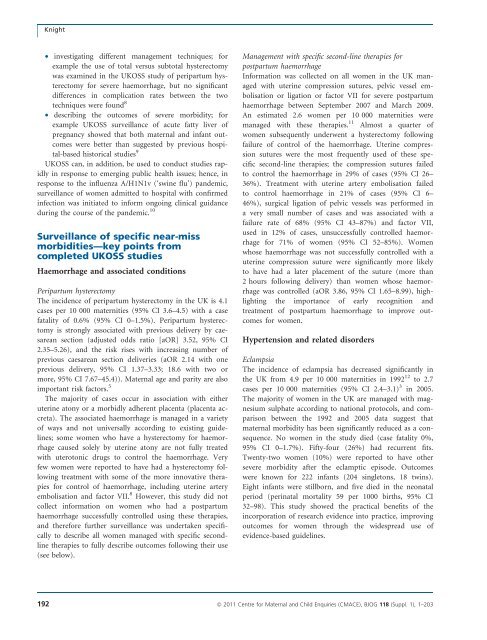6.-March-2011-Saving-Mothers-Lives-reviewing-maternal-deaths-to-make-motherhood-safer-2006-2008
6.-March-2011-Saving-Mothers-Lives-reviewing-maternal-deaths-to-make-motherhood-safer-2006-2008
6.-March-2011-Saving-Mothers-Lives-reviewing-maternal-deaths-to-make-motherhood-safer-2006-2008
Create successful ePaper yourself
Turn your PDF publications into a flip-book with our unique Google optimized e-Paper software.
Knight• investigating different management techniques; forexample the use of <strong>to</strong>tal versus sub<strong>to</strong>tal hysterec<strong>to</strong>mywas examined in the UKOSS study of peripartum hysterec<strong>to</strong>myfor severe haemorrhage, but no significantdifferences in complication rates between the twotechniques were found 8• describing the outcomes of severe morbidity; forexample UKOSS surveillance of acute fatty liver ofpregnancy showed that both <strong>maternal</strong> and infant outcomeswere better than suggested by previous hospital-basedhis<strong>to</strong>rical studies 9UKOSS can, in addition, be used <strong>to</strong> conduct studies rapidlyin response <strong>to</strong> emerging public health issues; hence, inresponse <strong>to</strong> the influenza A/H1N1v (‘swine flu’) pandemic,surveillance of women admitted <strong>to</strong> hospital with confirmedinfection was initiated <strong>to</strong> inform ongoing clinical guidanceduring the course of the pandemic. 10Surveillance of specific near-missmorbidities—key points fromcompleted UKOSS studiesHaemorrhage and associated conditionsPeripartum hysterec<strong>to</strong>myThe incidence of peripartum hysterec<strong>to</strong>my in the UK is 4.1cases per 10 000 maternities (95% CI 3.6–4.5) with a casefatality of 0.6% (95% CI 0–1.5%). Peripartum hysterec<strong>to</strong>myis strongly associated with previous delivery by caesareansection (adjusted odds ratio [aOR] 3.52, 95% CI2.35–5.26), and the risk rises with increasing number ofprevious caesarean section deliveries (aOR 2.14 with oneprevious delivery, 95% CI 1.37–3.33; 18.6 with two ormore, 95% CI 7.67–45.4)). Maternal age and parity are alsoimportant risk fac<strong>to</strong>rs. 5The majority of cases occur in association with eitheruterine a<strong>to</strong>ny or a morbidly adherent placenta (placenta accreta).The associated haemorrhage is managed in a varietyof ways and not universally according <strong>to</strong> existing guidelines;some women who have a hysterec<strong>to</strong>my for haemorrhagecaused solely by uterine a<strong>to</strong>ny are not fully treatedwith utero<strong>to</strong>nic drugs <strong>to</strong> control the haemorrhage. Veryfew women were reported <strong>to</strong> have had a hysterec<strong>to</strong>my followingtreatment with some of the more innovative therapiesfor control of haemorrhage, including uterine arteryembolisation and fac<strong>to</strong>r VII. 8 However, this study did notcollect information on women who had a postpartumhaemorrhage successfully controlled using these therapies,and therefore further surveillance was undertaken specifically<strong>to</strong> describe all women managed with specific secondlinetherapies <strong>to</strong> fully describe outcomes following their use(see below).Management with specific second-line therapies forpostpartum haemorrhageInformation was collected on all women in the UK managedwith uterine compression sutures, pelvic vessel embolisationor ligation or fac<strong>to</strong>r VII for severe postpartumhaemorrhage between September 2007 and <strong>March</strong> 2009.An estimated 2.6 women per 10 000 maternities weremanaged with these therapies. 11 Almost a quarter ofwomen subsequently underwent a hysterec<strong>to</strong>my followingfailure of control of the haemorrhage. Uterine compressionsutures were the most frequently used of these specificsecond-line therapies; the compression sutures failed<strong>to</strong> control the haemorrhage in 29% of cases (95% CI 26–36%). Treatment with uterine artery embolisation failed<strong>to</strong> control haemorrhage in 21% of cases (95% CI 6–46%), surgical ligation of pelvic vessels was performed ina very small number of cases and was associated with afailure rate of 68% (95% CI 43–87%) and fac<strong>to</strong>r VII,used in 12% of cases, unsuccessfully controlled haemorrhagefor 71% of women (95% CI 52–85%). Womenwhose haemorrhage was not successfully controlled with auterine compression suture were significantly more likely<strong>to</strong> have had a later placement of the suture (more than2 hours following delivery) than women whose haemorrhagewas controlled (aOR 3.86, 95% CI 1.65–8.99), highlightingthe importance of early recognition andtreatment of postpartum haemorrhage <strong>to</strong> improve outcomesfor women.Hypertension and related disordersEclampsiaThe incidence of eclampsia has decreased significantly inthe UK from 4.9 per 10 000 maternities in 1992 12 <strong>to</strong> 2.7cases per 10 000 maternities (95% CI 2.4–3.1) 3 in 2005.The majority of women in the UK are managed with magnesiumsulphate according <strong>to</strong> national pro<strong>to</strong>cols, and comparisonbetween the 1992 and 2005 data suggest that<strong>maternal</strong> morbidity has been significantly reduced as a consequence.No women in the study died (case fatality 0%,95% CI 0–1.7%). Fifty-four (26%) had recurrent fits.Twenty-two women (10%) were reported <strong>to</strong> have othersevere morbidity after the eclamptic episode. Outcomeswere known for 222 infants (204 single<strong>to</strong>ns, 18 twins).Eight infants were stillborn, and five died in the neonatalperiod (perinatal mortality 59 per 1000 births, 95% CI32–98). This study showed the practical benefits of theincorporation of research evidence in<strong>to</strong> practice, improvingoutcomes for women through the widespread use ofevidence-based guidelines.192 ª <strong>2011</strong> Centre for Maternal and Child Enquiries (CMACE), BJOG 118 (Suppl. 1), 1–203


